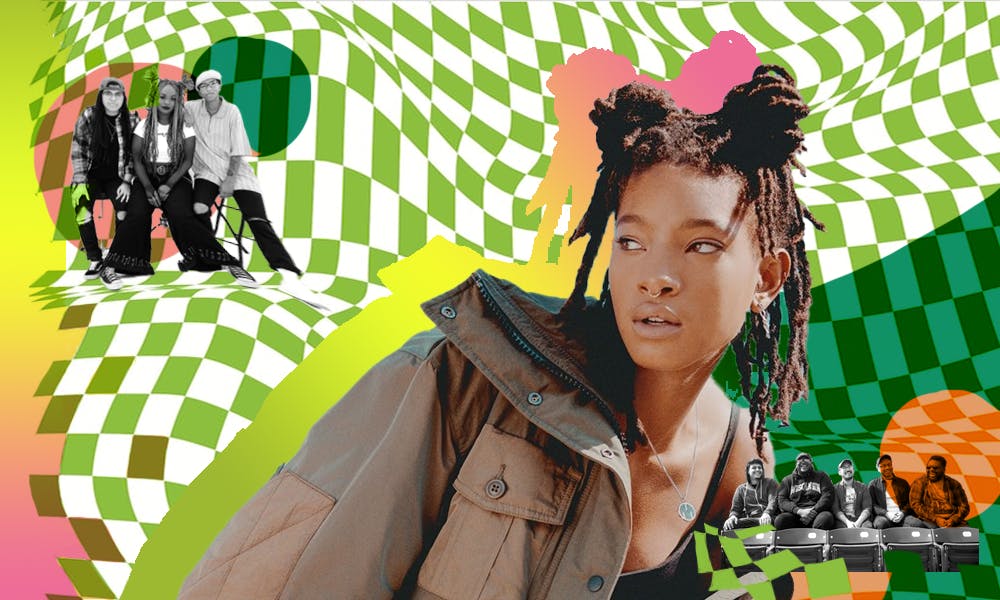The sound of Pop–punk is unmistakable—fast tempo, infectious melody, a wall of sound composed of roaring electric guitars and thumping drums, and very angry youth.
Pop–punk was a staple of the 90s and 2000s that fizzled out as other genres like rap gained popularity. But guess what—it’s now back and better than ever. This time, it’s diverse and features artists of color like Willow Smith (also known simply as Willow). Unfortunately, the diversity of the revival is more performative than it is progressive.
Those that grew up in the '90s and 2000s are deeply acquainted with bands such as Blink–182, Dag Nasty, Green Day, Descendants, Paramore, and more. They were the anthem of a generation of youth that refused to sit down and take the political and social injustice of the world around them. They had something to say and would say it regardless of what ‘the man’ wanted.
However, in the 90s and 2000s, Pop–punk wasn’t the only music genre gaining steam. Hip–hop was becoming increasingly popular and this led to a stark demographic split. Pop–punk was overwhelmingly white, and Hip–hop became the genre for people of color.
But music is meant to be shared and spread regardless of color. White teens became enthralled with Hip–hop and teens of color expanded their musical tastes into Pop–punk. Today, there are several white rappers such as Eminem that have irrevocably influenced rap and earned their place as genre legends. Unfortunately, the same can’t be said for Pop–punk and artists of color. Pop–punk is still overpoweringly white, despite the new diverse slant championed by the revival.
When the diversity of the Pop–punk revival is discussed, Willow’s album lately I feel EVERYTHING is presented as proof of a newfound progressiveness in the genre.
Willow is an artist so entrenched in Gen Z culture that her success was almost inevitable. This isn’t to reduce Willow’s efforts and talent. As a Black woman, breaking into a majority white genre is never easy. Her voice is striking and her lyrics are potent and emotional, but she’s been famous since before she was born. Her notable family consisting of Will, Jaden, and Jada Pinkett Smith are lovable Black Hollywood royalty. At nine years old, Willow began her music career with the Platinum hit “Whip My Hair” and has been beloved by Gen Z ever since.
If that wasn't enough for a successful album or at least increased attention to the album, she collaborated with a bonafide Pop–punk Legend—Travis Barker, the drummer of Blink–182. Her album blew up and now has hundreds of millions of Spotify streams.
But what about the other youth of color embracing Pop–punk? They aren’t finding it quite as easy as Willow to gain traction. While Willow’s Pop–punk arrival was a perfect storm, those without her connections aren’t as lucky.
POC Pop–punk bands such as Meet Me @ The Altar and Action/Adventure still aren’t as popular in mainstream Pop–punk, presumably because they don’t fit its white mold. Aside from Willow, the revival has been mostly white artists such as Machine Gun Kelly and YungBlud.
Meet Me @ The Altar has been lauded by Pop–punk greats including Green Day for their most popular song “Garden.” It’s an uplifting Paramore–inspired banger about an unbreakable friendship. Yet, they fail to receive mainstream attention. While their single “Garden” has 1.7 million Spotify streams and almost 400,000 YouTube views, despite this initial success, it still pales in comparison to their white counterparts.
Action/Adventure faces similar issues. They posted a video singing lyrics from their most popular song “Barricades” on TikTok. In the video, their frontman Blake Evaristo is raw and vulnerable as he questions listeners “Would you listen if we looked any different?” With 1.3 million views, Action/Adventure has clearly struck a nerve with listeners. The comment section is flooded with support from listeners eager for good music and more diversity in the genre. On Spotify, “Barricades” has just over 400,000 streams. The disconnect is clear on YouTube though, where the official “Barricades” music video has 50,000 views.
To put these numbers in perspective, one of Machine Gun Kelly’s most popular songs, “my ex’s best friend,” featuring Blackbear, has almost 400 million Spotify streams regardless of the fact that he only just transitioned into Pop–punk after starting his career as a rapper.
It’s clear that the Pop–punk revival isn’t as diverse as it seems. But a slow start doesn’t mean real progress can’t be made. POC Pop–punk bands aren’t demeaning other successful white Pop–punk artists. They enjoy the genre of Pop–punk as deeply and enthusiastically as anyone else. They simply want a chance to be heard without prejudice maligning judgments of their talents. And to their credit, they’re good—really good.
Pop–punk fans will surely be impressed by the infectious melodies, powerhouse vocals, and heartfelt lyrics of Meet Me @ the Altar, Action/Adventure, and other artists of color making waves on the Pop–punk scene. But it’s hard to be impressed by a band that you don’t even know exists. Perhaps Pop–punk fans need to actively seek out bands that are more anti–establishment towards the genre. Willow shouldn’t have to be the only POC Pop–punk artist, there’s a slew of talented artists waiting to join her at the top.

